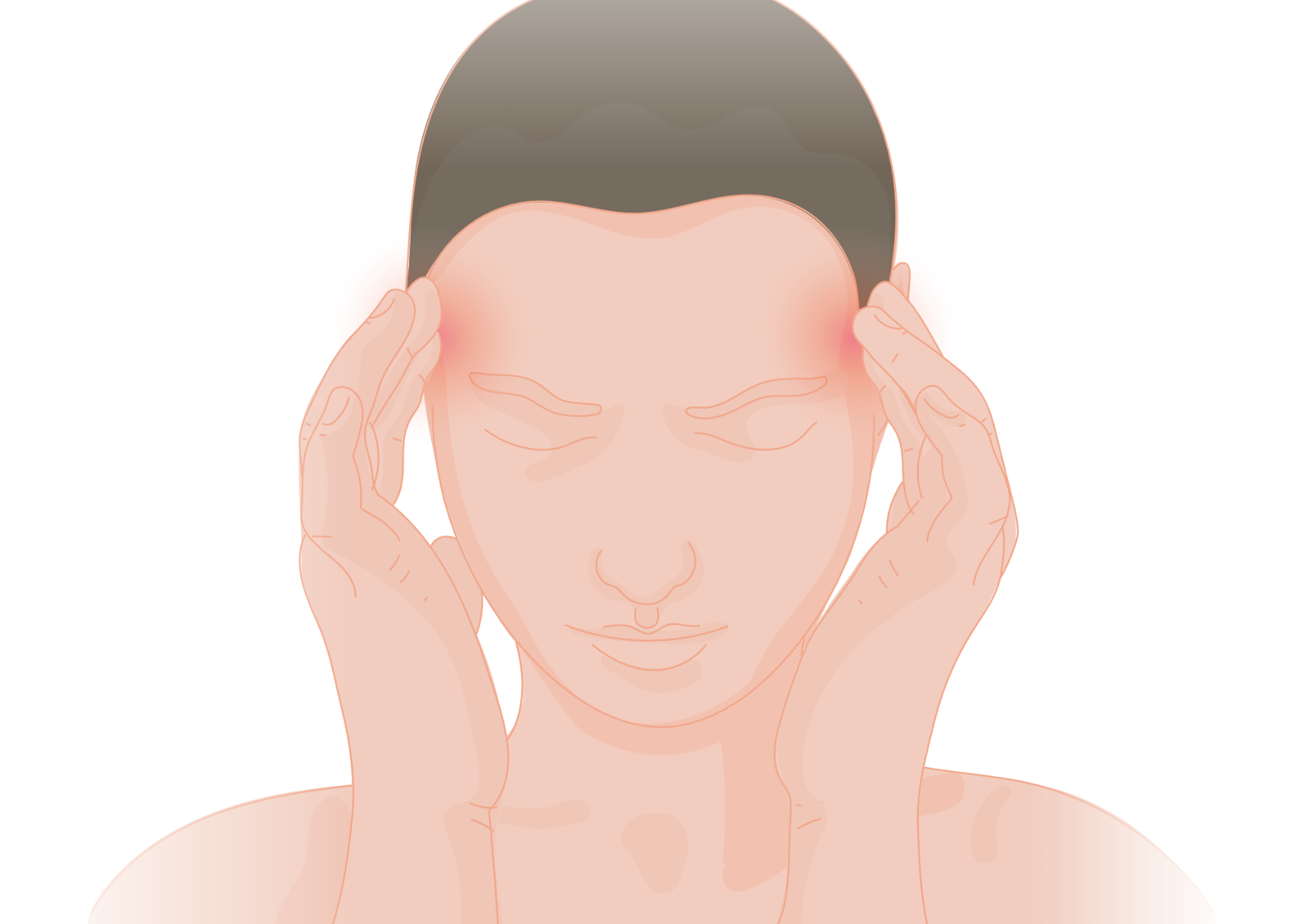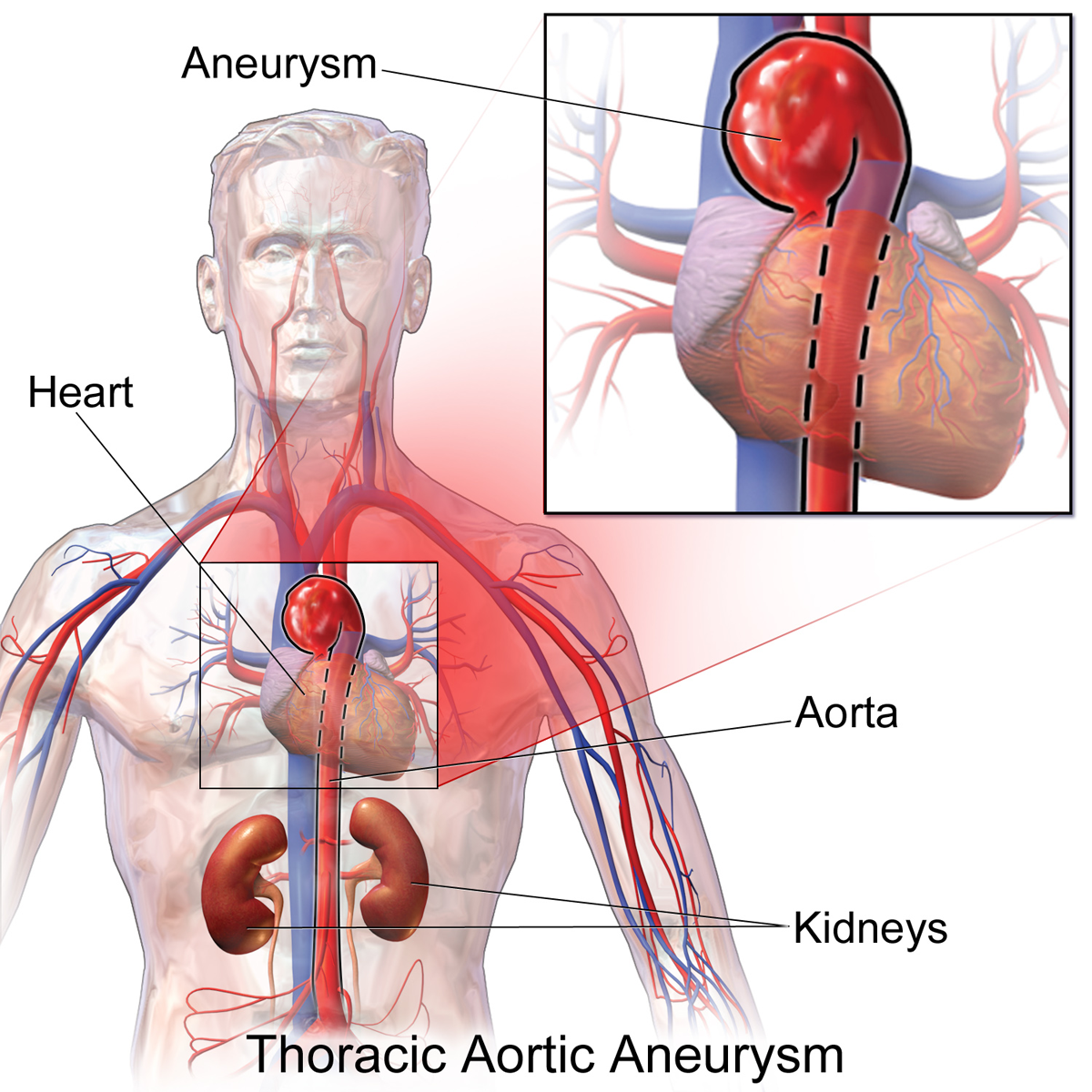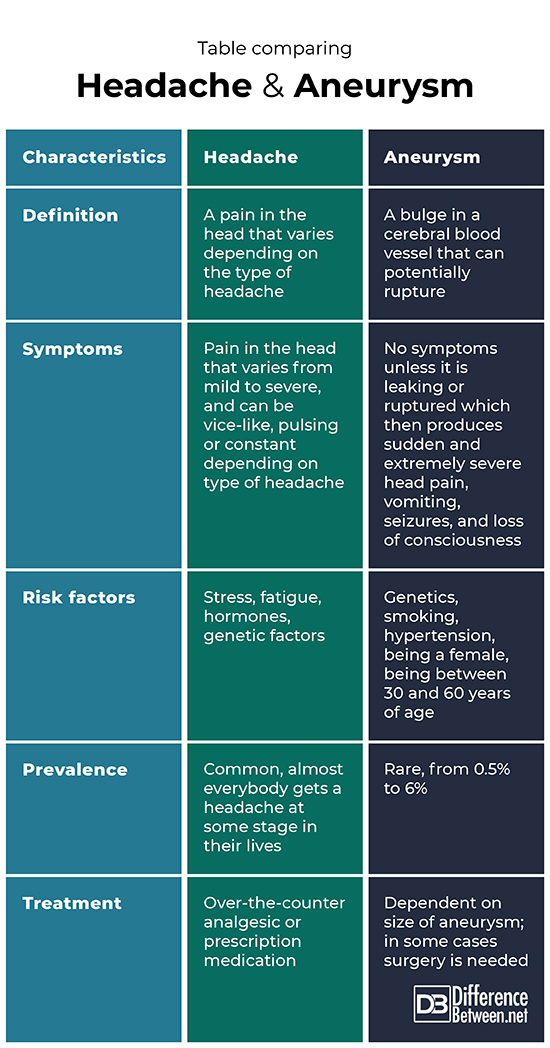Difference Between Headache and Aneurysm
A headache is a pain that is felt in the head that can vary in the location and type of pain. An aneurysm is a bulge that forms in a blood vessel.

What is Headache?
Definition:
A headache is a pain in the head that can vary from mild to severe and which varies in the location and nature of the pain.
Symptoms:
The most common symptom of a headache is always pain, however the pain varies from mild to more severe and the location of the pain is variable depending on the type of headache. This is because there are different types of headache, for instance, a tension headache causes a constant vice-like pain but a migraine typically causes pulsing pain on one side of the head. A cluster headache will cause pain around or behind an eye. The pain from a headache is also not sudden but usually starts gradually or there is an aura beforehand (in the case of migraines). This is an important difference from an aneurysm.
Diagnosis:
Diagnosis is by a physical exam and a doctor noting symptoms. Imaging techniques such as X-ray or MRI are sometimes used to eliminate other causes of head pain, such as brain tumors or aneurysms. It is important that the correct diagnosis is made as while a headache is not deadly, an aneurysm can be since it can cause a brain bleed. Knowing that you have a headache rather than an aneurysm and knowing what type of headache is also essential for finding the correct treatment options.
Causes and risk factors:
Several factors can cause a headache, including stress and fatigue to hormonal changes and even food allergies. There are also certain medications that can cause headache as a side effect. Some people are more prone to having certain types of headaches because of genetic factors.
Treatment:
The type of medication that is most effective depends on the type of headache. For mild headaches, analgesics such as aspirin and acetaminophen may work fine. For severe headaches like migraine or cluster headaches, prescription medications are often needed.

What is Aneurysm?
Definition:
An aneurysm is a problem in the brain vasculature; an area of a blood vessel swells outwards resembling a balloon.
Symptoms:
There are often no symptoms unless the aneurysm has started to leak or it has actually burst. An ominous sign is having the worst headache one has ever had accompanied by symptoms such as seizures, vomiting and loss of consciousness. The pain from a leaking or ruptured aneurysm would be much worse than a simple headache. Unlike a typical headache the pain from a burst aneurysm is very sudden and extreme. This is a way one can distinguish it from a headache, the head pain happens extremely rapidly and it is intensely painful. It is important for doctors to distinguish between the causes of head pain since an aneurysm that is leaking or ruptured is a very dangerous condition.
Diagnosis:
An aneurysm can be diagnosed through angiography combined with an X-ray or MRI that can show the defect in the blood vessel. In angiography a special contrast dye is injected into the body so that the blood vasculature can be visualized. A person who is concerned about head pain should see a doctor who can test if it is a headache versus aneurysm. It is important to understand that headaches are more common but only a doctor can diagnose the problem properly.
Causes and risk factors:
The cause of an aneurysm is often not known although there may be some genetic factors or development problems involved. There are, however, some factors that do increase the risk of a cerebral aneurysm. People most at risk are those who are between 30 and 60 years of age and more often women than men. Certain illnesses can increase a person’s risk, such as polycystic kidney disease or having a connective tissue disease. Smoking cigarettes and having high blood pressure also increase a person’s chance of an aneurysm forming.
Treatment:
If an aneurysm is smaller than 7 mm and not producing symptoms then it is not normally treated. At larger sizes, the aneurysm may be treated surgically through placement of stents or coils or embolization. Some aneurysms caused by an infection can be treated with antimicrobial therapy.
Difference between Headache and Aneurysm?
Definition
A headache can be defined as a pain in the head that varies depending on the type of headache. An aneurysm can be defined as a bulge in a cerebral blood vessel that can potentially rupture.
Symptoms
The symptoms of a headache include a pain in the head that varies from mild to severe, can be vice-like, pulsing or constant depending on type of headache. An aneurysm will usually produce no symptoms unless it is leaking or ruptured; the symptoms then are a sudden and extremely severe head pain, vomiting, seizures, and loss of consciousness
Risk factors
The risk factors for a headache include stress, fatigue, hormones, and genetic factors. The risk factors for an aneurysm include genetics, smoking, hypertension, being a female, and being between 30 and 60 years of age.
Prevalence
Headaches are very common and most everybody has a headache at some stage during their lifetime. Aneurysms are rare with only about from 0.5% to 6% of people developing an aneurysm.
Treatment
Usually over-the-counter analgesic or prescription medication is used to treat a headache. Treatment for an aneurysm depends on the size of the swelling and may necessitate surgery.
Table comparing Headache and Aneurysm

Summary of Headache Vs. Aneurysm
- A headache is a pain that is felt in the head; the nature and location of the pain varies depending on the type of headache.
- An aneurysm is a bulging of a blood vessel in the brain; an aneurysm can potentially rupture.
- The pain of a headache is common and it does not happen as suddenly as the pain of an aneurysm that is bleeding.
- Headaches are common and vary from mild pain to severe.
- An aneurysm may have no symptoms or cause very sudden and severe pain if it starts to leak or ruptures.
- Difference Between Rumination and Regurgitation - June 13, 2024
- Difference Between Pyelectasis and Hydronephrosis - June 4, 2024
- Difference Between Cellulitis and Erysipelas - June 1, 2024
Search DifferenceBetween.net :
Leave a Response
References :
[0]Chong, Ji Y. “Brain Aneurysms”. Merckmanuals. Merck & Co., 2020, https://www.merckmanuals.com/professional/neurologic-disorders/stroke/brain-aneurysms?query=brain%20aneurysm
[1]Chong, Ji Y. “Brain Aneurysms”. Merckmanuals. Merck & Co., 2020, https://www.merckmanuals.com/professional/neurologic-disorders/stroke/brain-aneurysms?query=brain%20aneurysm
[2]Silberstein, Stephen D. “Cluster Headache”. Merckmanuals. Merck & Co., 2018, https://www.merckmanuals.com/professional/neurologic-disorders/headache/cluster-headache
[3]Silberstein, Stephen D. “Tension-Type Headache”. Merckmanuals. Merck & Co., 2020, https://www.msdmanuals.com/professional/neurologic-disorders/headache/tension-type-headache
[4]Image credit: https://commons.wikimedia.org/wiki/File:Thoracic_Aortic_Aneurysm.png
[5]Image credit: https://commons.wikimedia.org/wiki/File:Headache.png
